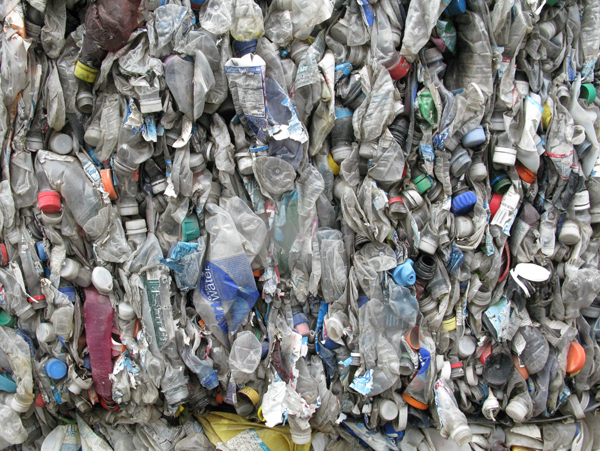
Last week I wrote an article about how my city — San Francisco — has reached a stunning 78% waste diversion rate and is on the way to its stated goal of zero waste in 2020. It describes the city’s history of dealing with waste, from volunteer-run community recycling centers dating back to the first Earth Day and early compliance with AB 939 (California’s 1989 mandate requiring 50 percent of waste diversion by 2000) to the city’s 2002 zero waste resolution and 2009 landmark Mandatory Recycling and Composting Ordinance.
It details the city’s state of the art three-stream collection system and how this first in the nation large-scale urban food waste and composting program has returned 1 million tons of nutrient-rich compost to residents’ dinner tables in the form of fresh food from local farms, reducing the city’s greenhouse gas emissions to 12 percent below 1990 levels.
It chronicles how the city by the bay has even been able to tackle — against the usual hippie, commie, and big daddy accusations — some of the most sacred cows of modern convenience, by banning or at least reflecting the true cost of single-use plastic bags.
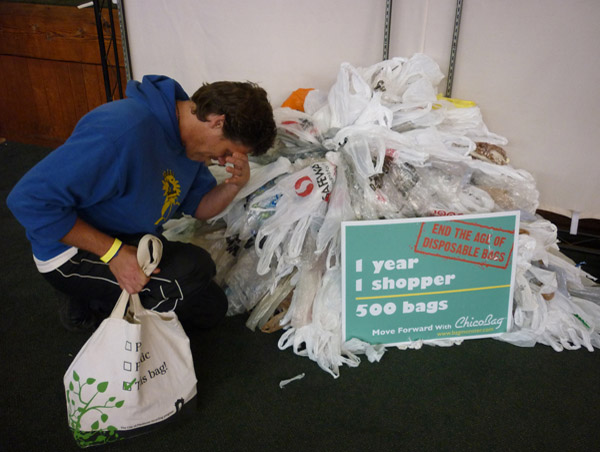
San Francisco’s groundbreaking waste diversion efforts and programs have been truly visionary, earning it the mantle of “greenest” major city in the US and Canada Green City Index and making it a model for other municipalities. And yet, despite all the achievements and accolades there’s a million pound gorilla in the room that weighs down our city and landfill, as well as marine and terrestrial environments:
Whether it’s containers,
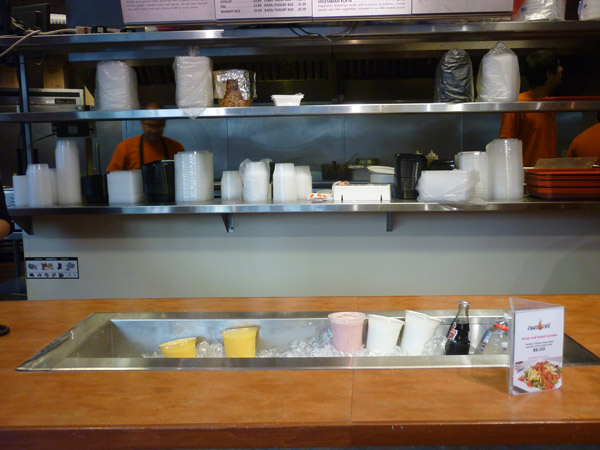
bottles,
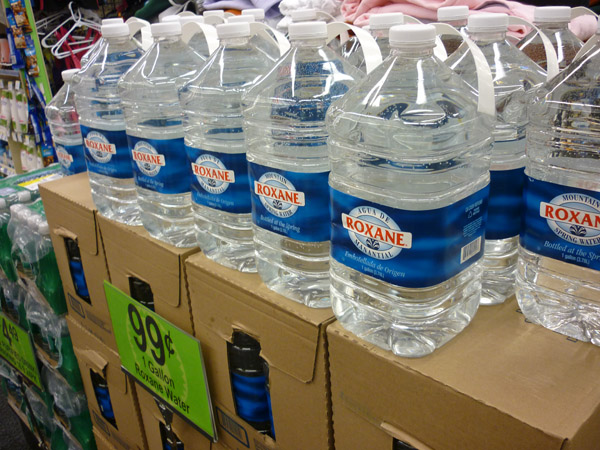
or food packaging,
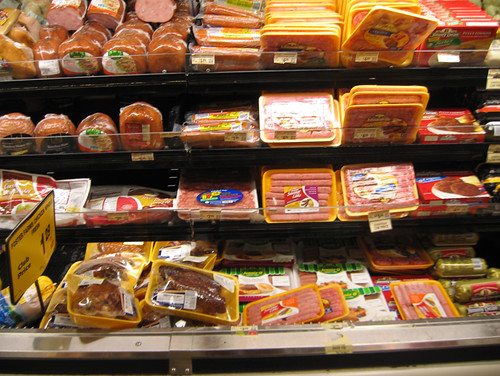
the explosion of single-use disposable plastic over the last 30 years is posing problems that go far beyond any city’s recycling program and much deeper into the question of who we are as citizens, sentient beings and inhabitants of a planet with finite resources and a fragile ecosystem. Basically, one of the biggest and dirtiest secrets our collective lazy-bone and the plastics industry is trying very hard to keep out of our consciousness is that plastic, even if it does end up in the recycling bin, isn’t recyclable.
The Plastic Pollution Coalition points out The Recycling Myth:
Collecting plastics at curbside fosters the belief that, like aluminum and glass, these will be converted into new similar objects. This is not the case with plastic. The best we can hope for plastics is that these will be turned into other products such as doormats, textiles, plastic lumber, etc. These products will still end at some point in the landfill – and do not stem the need for more virgin petroleum product. This is not recycling, but down-cycling. (boldface mine)
But not even down-cycling is happening.
In the US, 93% of plastics are NOT recovered (put in plastic “recycling” bins). These go straight to landfills. PET bottles that have a redemption value (cash value) fare a bit better: 62% are NOT recovered.
What this means is that just because your bottle or package says that it can be recycled doesn’t mean that it will be or that it will reduce your city’s waste stream. Chances are it won’t. Even if you count plastic downcycling as recycling and your city has a blue recycling bin, there’s something in those three arrows on a container that seems to give our poor beleaguered eco souls automatic license to consume more.
“Hey, it says it’s recyclable, so I can have as many as I want, right? Grab another bag of Puffcorn!”
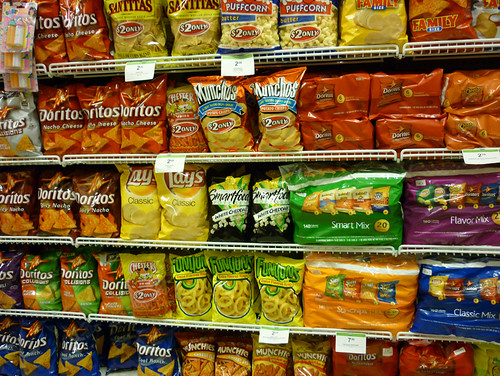
The numbers tell the story: While 34 percent — or 85 million tons out of a total 250 million tons of trash generated in the U.S. in 2010 — was recycled, up from only 10 percent in 1980, per capita solid waste generation in the U.S. has actually increased from 3.66 to 4.43 pounds per person per day in the same time span. In other words, whatever dent Americans are making into their garbage through recycling is still offset by increased consumption and disposal.
No matter how you slice it, most of our plastic items will ultimately end up in the landfill (or the ocean) sooner (in most of the U.S.) or later (in San Francisco), where the polyethylenes, polystyrenes, polyvinyl chlorides, and all the other polys will last several hundred years after having served us sometimes for mere minutes. San Francisco has shown how the right infrastructure, technology and political will can get a large chunk of stuff out of the waste stream, but unless there’s a more fundamental change in behavior, the combination of unsustainable and messy materials like plastics and a deeply-ingrained throw-away mentality will keep our dump busy and zero waste sounding good in theory only.

The Lunchbox Project
Right after I had submitted my article pondering these tremendous challenges San Francisco will be facing in getting from 78 percent waste diversion (what I call the low-hanging fruit) to 100 percent, I was forwarded an email from Deb Baida, my partner in reusability, about a planned action in downtown San Francisco called The Lunchbox Project. Organized by Brendan Moriarty, a financial district worker concerned about the rampant use of single-use dishes and containers during lunch hour, the Lunchbox Project invited people to come down to Crocker Galleria, a downtown mall with shops and restaurants, and order lunch in their own reusable containers in a way that attracts attention and inspires others to do the same.
It was the kind of action that I thought held the key to the missing 22 percent, so Deb and I grabbed our glassware and hopped on BART to join the party.
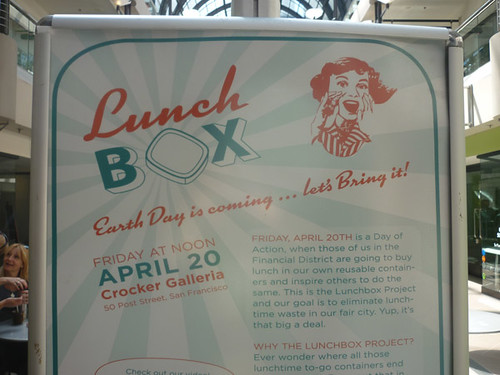
Our first impression upon entering Crocker Galleria was the perfect example of the huge gap that still exists between talking green and living green, and how far we still have to go in raising awareness and connecting mere words to deeds. Will the earth really benefit from these balloons? Where will the balloons be next week? Next month? Next century?
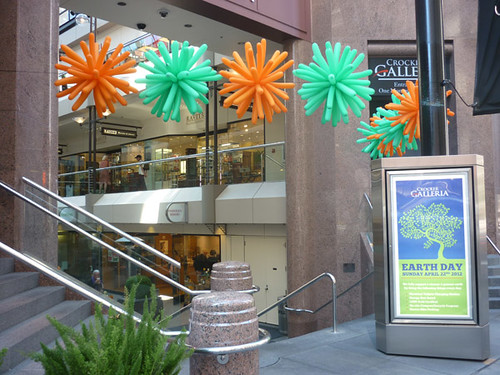
Our second impression was a plastic monster cut from an entirely different bag.
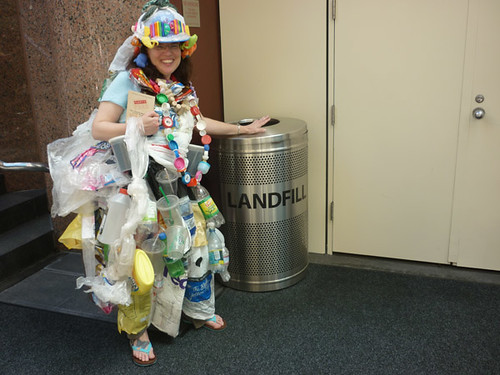
Beth Terry is one of the most tireless, creative, and fun plastic-free advocates this side of the Great Pacific Garbage Patch, chronicling the journey of reducing her plastic consumption to 2.11 pounds in 2011 (the average American generates at least 100 pounds of plastic waste per year!). Ever since she saw a photo of a dead sea bird with its belly full of plastic pieces, she resolved to stop buying any new plastic and has been spreading all kinds of important tips and resources through her My Plastic-free Life (formerly Fake Plastic Fish) blog, also chronicled in her upcoming book, Plastic Free — How I Kicked the Plastic Habit and How You Can Too. Deb and Beth have become good buddies through their respective shedding-stuff-from-your-life missions, so it was only natural to see them geek out together.
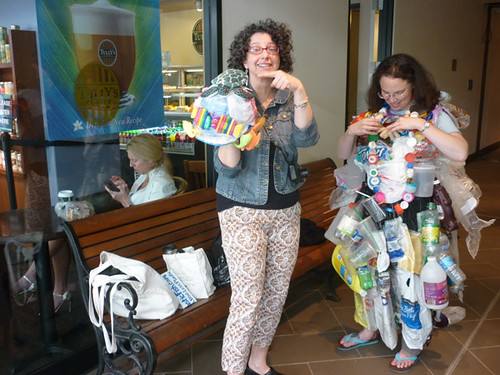
After getting Beth “dressed” we walked up the lobby where a pretty good crowd of reusable warriors had gathered, ready to order.
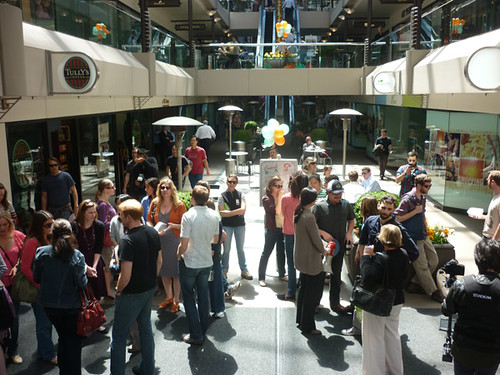
It was great to see the fine folks from the San Francisco Department of Environment out and about,
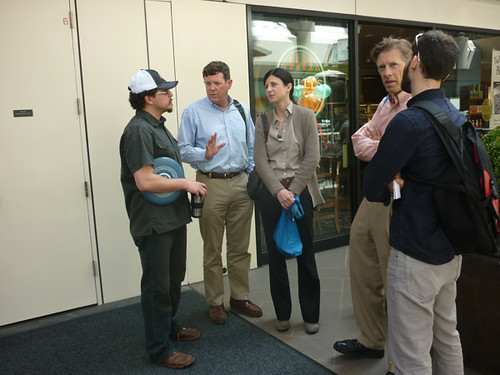
sporting some of the slickest,
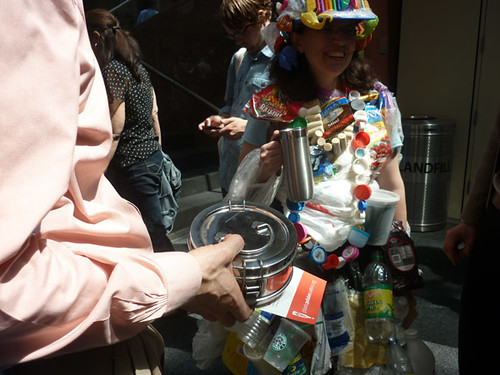
and grooviest lunch dishes
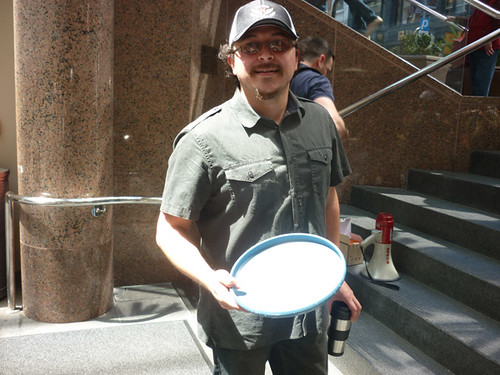
Donnie Oliveira, SF Environment’s Grassroots Program Manager and owner of the Frisbee plate, confirmed to me just what I had suspected, that disposable plastics are one of the most significant obstacles in the city’s zero waste mission. And of all places in San Francisco, the financial district is one of the biggest problem areas, as most people only come there for work and are in a constant rush, including their eating habits. The restaurants cater to that fast food mentality, many of them not even offering the option of reusable dishes and silverware.
As I was following Beth into Tully’s to get a cup of water, you could tell by their set-up what the default beverage container is.
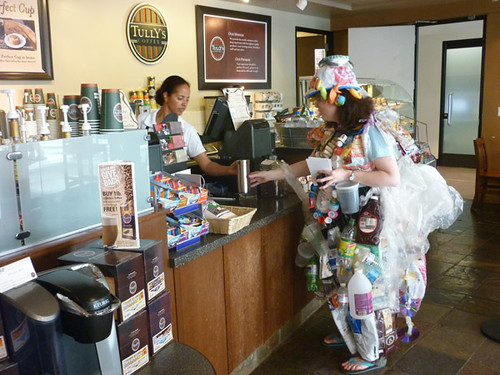
You may wonder “well, what about those awesome composting and recycling bins, isn’t that where all this stuff goes?” It’s a great question, and it once again raises the issue of feelgood complacency. Just because the green and blue bins are there doesn’t mean that everything ends up where it belongs. For example, in case of the coffee cups, the cups themselves go into the green composting bin, whereas the plastic lids go into the blue recycling bin. A lot of folks who are either too busy, too lazy, or don’t pay attention will toss plastic lids into the compost bin and paper cups into the recycling bin, which means they’re both going to landfill after being sorted out at the composting and recycling facilities.

photo by Debra Baida
That’s why getting people to bring their own lunch containers is such a win-win-win. Not only do you keep stuff from ending up in the wrong bin, but you eliminate the need for single-use containers in the first place, as well as create a more conscious and educated citizenry who knows that reducing consumption is the most meaningful environmental act one can engage in.
And that’s exactly the message Lunchbox organizer Brendan Moriarty, Plastic Pollution Coalition‘s Daniella Russo, Plastic-free Beth Terry, and Eco Lunchbox founder Sandra Harris were shouting out.
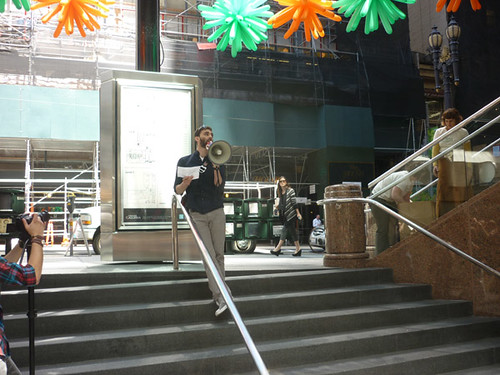
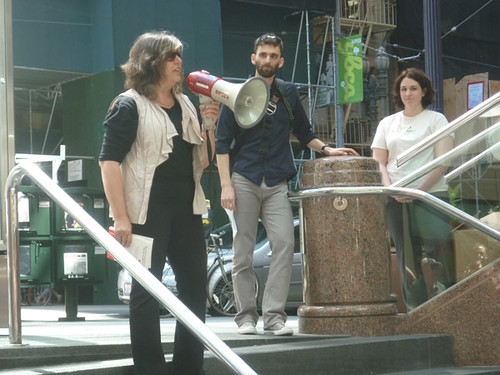

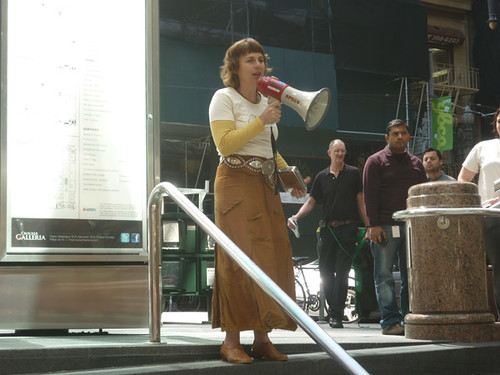
before sending us off into the disposable jungle.
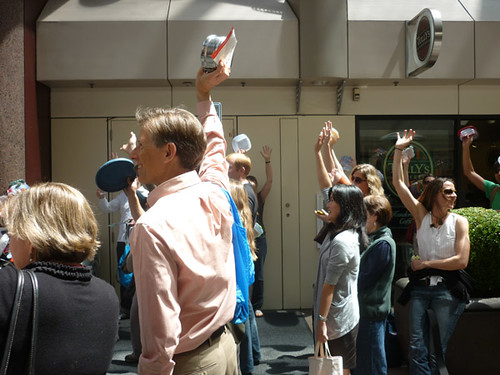
Jack Macy, Commercial Zero Waste Coordinator at the Department of Environment, lifts his reusable lunch box
The Frisbee Challenge
I’m not sure whether it was my journalistic instincts or my inner dog, but from the moment I saw Donnie and his Frisbee I knew I’d be following him once the action started. Sure, there were folks with way more fancy lunch boxes, and yes, that Frisbee is made of plastic, but it looked like it had been around the SF culinary block, with the battle scars to tell the story, and I wanted to see people’s reaction to it.
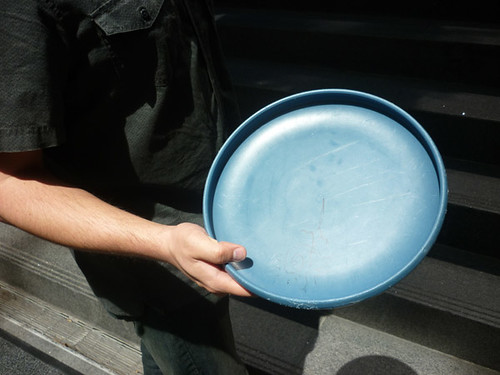
As he was trying to decide where he was going to have lunch, teetering between Indian, Mexican and BBQ, poor Donnie must have indeed felt like I was some stray dog on his coattails, tagging along with expectant eyes, in search for scraps. I thought it best to tell him my true intention, and once he was assured that it wasn’t his food I was after he immediately warmed up to his new personal paparazzi.
He settled on Indian, and we got in line at the place that was getting ready for the lunch rush with a wall of plastic containers.
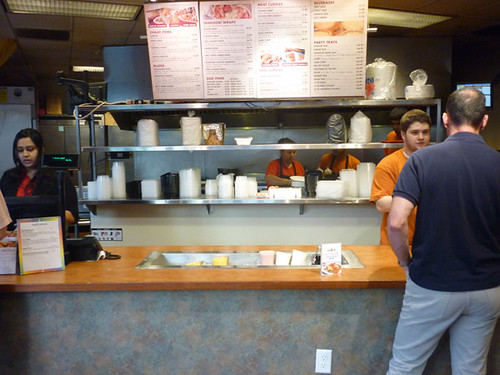
When it came time for Donnie to order, the friendly girl at the cash register did a great job at pretending that this was an order like any other…

until she cracked.
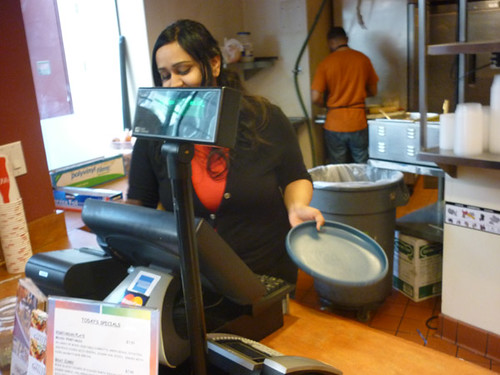
Donnie’s plate then was properly handled and prepped by one of the cooks…

before getting in line with the competition.
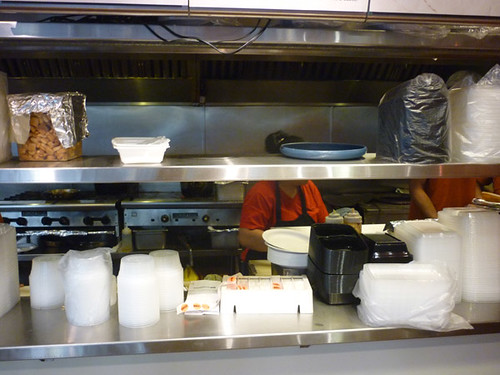
Everything was going as planned without a hitch, until….NOOOOOOOO, DON’T DO IT!
Too late…
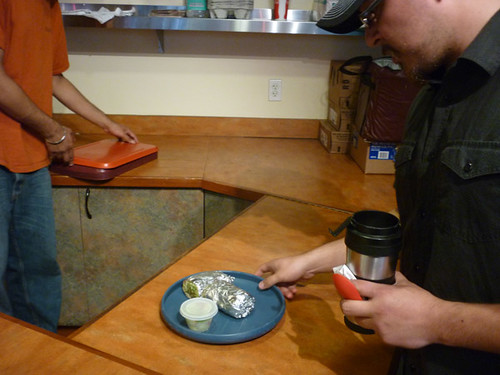
Yes kids, this is really what happened. Donnie’s Frisbee, after all that talk, giddy anticipation, and steely determination, came out of the kitchen loaded with a Tandoori wrapped in aluminum and a salad prepackaged in a plastic container.
Sure, from a practical perspective it makes sense. The good folks at the Indian place are expecting a big lunch rush and so they have everything pre-wrapped and -packaged, ready to be “dished” out without a hitch. It’s no secret that mass production is most efficient when everything and everyone is on auto-pilot, and if the default setting is a plastic wrapper, then the reusable dish simply does not compute. (Those of us who have ever brought a reusable bag to the grocery store know how vigilant you have to be to thwart the disposable auto-pilot. Before you know it, your groceries are already in the plastic bag, and asking the checker to take them out again can lead not only to bewilderment but the unused plastic bag tossed in the trash rather than being used for another customer. Argh!)
But what if the majority of diners brought a reusable container, thus making it the default? The servers could be just as speedy in getting the food in the reusable container, plus the restaurant would save a lot of money on the cost of all the plastic and cardboard.
Though disappointed, Donnie was a good sport and went on to enjoy his lunch.
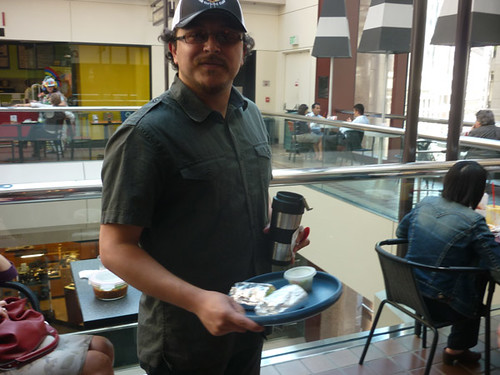
As I was walking around the patio it quickly became clear why this is such an uphill battle and why it was such a perfect location for the Lunchbox Project. This place was one big eat-n-toss party!
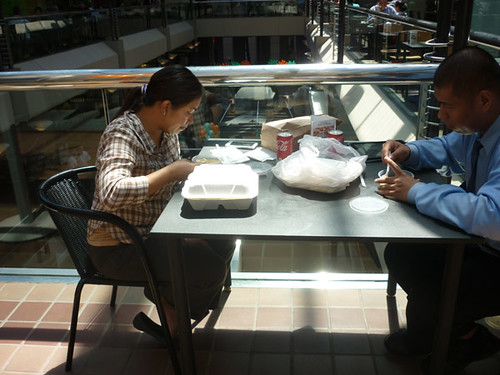
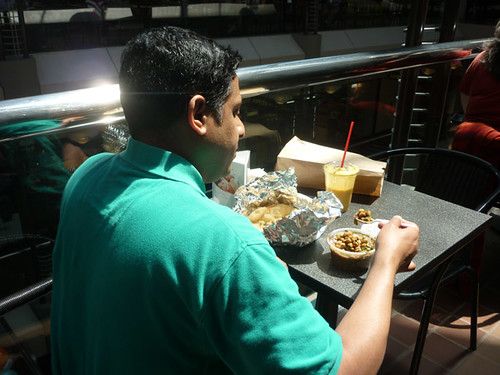
It doesn’t look like much on your own small table,
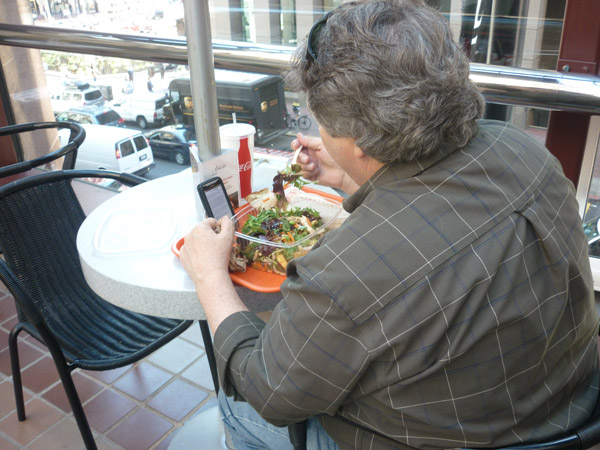
but when you put it all together it’s quite stunning how big of a mountain of trash this place produced in just one hour. The trash cans were literally overflowing, keeping the janitor very busy.
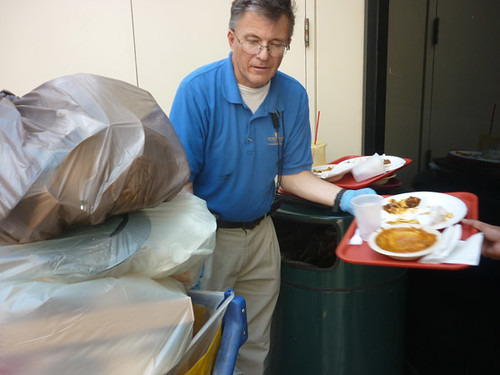
I walked over to the other side of the patio to catch up with some other lunchbox ambassadors. Outside a sushi place Beth was having a friendly talk with a diner, doing the educational and inspirational work necessary to change behaviors. This guy looked like someone who was just waiting for permission to bring his own lunch box next time. If this woman can run around in a laundry-detergent suit and a plastic fish hat, there’s no reason we can’t cause a little break in the disposable routine by bringing our own lunch box, don’t ya think?
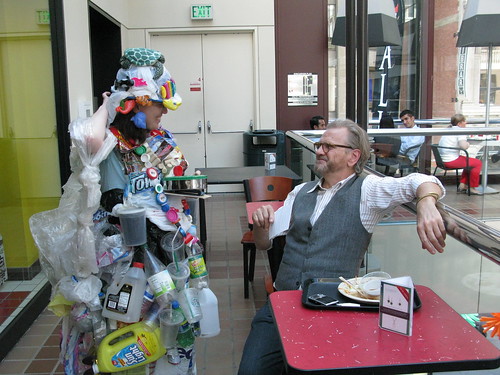
photo by Debra Baida
Inside, Jessica Connolly of San Mateo Recology and her friend Nathan Rogers were flaunting their reusable containers…
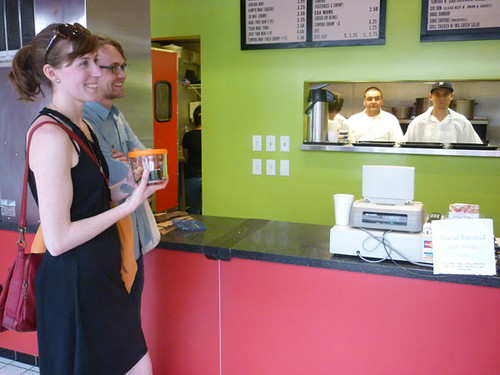
and declared victory in getting their sushi placed in them unwrapped and unpackaged.
Until…
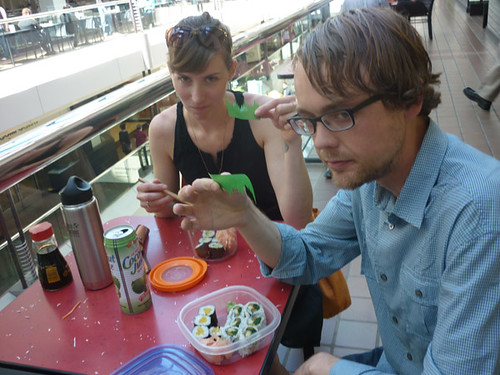
In a way, fake ornamental leaves in our food are the perfect symbol for how intertwined we’ve become with single-use plastic, how deeply these petrochemicals bleed into every aspect of our lives, and how hard it is to separate ourselves from them. Not only have these materials that are so harmful to the planet’s ecosystem become seemingly indispensable to our daily routines but they’ve entered our entire inner and outer operating systems to the point where we often don’t even notice their presence.
Whether it’s the City of San Francisco struggling to get to Zero Waste or Beth Terry attempting to live without single-use plastics, the lesson I think is the same: Once you dig deeper into the how’s and why’s of the waste we create, you realize that this issue goes far beyond recycling and into human behavior and consciousness. As I wrote at the end of Where No City Has Gone Before: San Francisco Will Be World’s First Zero-Waste Town by 2020, the closer you get to no waste at all, the deeper you wade into territories that are no longer about stuff, but about culture and consciousness and understanding your place in the cycle.
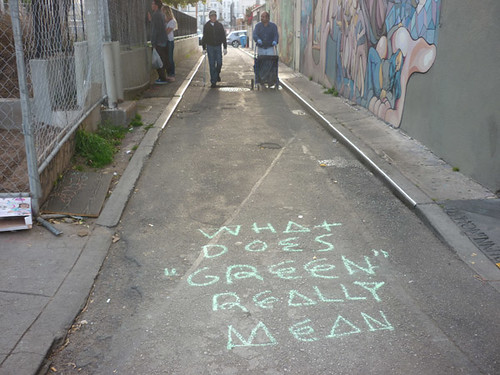
I think it’s quite ironic how government here in the U.S. has become typecast as the bogeyman who supposedly takes away our freedoms and choices, while there are entire industries who are allowed to inundate the market with such a large volume of toxic products that we literally cannot escape from, even if we try. Perhaps even harder to grasp for me is how these same industries can get away with the same “free market” justification of this plastic onslaught when they’ve externalized the true cost of their products to people and planet, who end up paying such a steep price for disposal, pollution and resource depletion.
But it’s also true that We the People, the public, the consumer, are not blameless in this. The only way it could get to this is because we have let these industries sell us on the ease, convenience and shine of these products, without questioning their impact beyond our immediate scope. We’ve followed the lure of instant gratification and supposed bottomless abundance because it saved us a little bit of extra work, time or thinking, and put up our collective blinders on the effects this sort of wasteful consumption might have on the planet and future generations who will wonder why we wasted such precious and non-renewable petroleum on a billion snacks.
This is why actions like The Lunchbox Project are so important: they help to wake each other up and reclaim an appreciation for the finite resources we are blessed with on this planet. They make us more sensitive to and conscious of all the things that seem to just miraculously fall into our hands every day, what it took to get them to us and what will happen to them after they leave our hands. Since the companies who make these products don’t tell us that information, it falls to us citizens to educate ourselves and each other to get to a collective understanding that on a finite planet there is no “away” to throw things.
Once you know the true cost of that single-use plastic container, you can’t help but look at it with different eyes, wearing a different hat, and eating from a different plate.
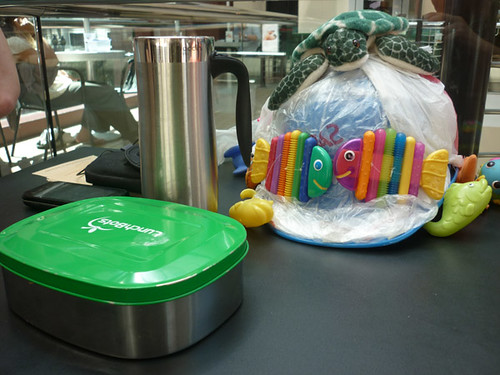
o~O~o~O~o~O~o~O~o~O~o~O~o~O~o~O~o~O~o
crossposted at Daily Kos
Also check out Beth‘s and Deb‘s posts from Lunchbox Day.
Resources:
My Plastic-Free Life
Plastic Pollution Coalition
SF Environment
Eco Lunchboxes
Clean Water Action
Other important organizations








[…] you can read and see in Sven’s post about the afternoon’s happenings, it wasn’t easy all the way around, especially for the […]
My dear, you summed this up so beautifully! Do you remember what happened to the plastic sushi grass?
no, what happened with it. Did Beth take it home?
Great post! I did a bunch of zero waste fast food adventures to prove that it is possible. Even McDonalds was willing to do it for me. I photographed the meals and blogged about it. Now I stick to Subway for the most part. They make my sandwich like everyone elses – on brown paper towel but then I insist that it is not transfered to the special paper, stuck in a plastic bag and stuffed with paper towel. http://stephaniegetsridofhercrap.wordpress.com/2011/07/08/zero-waste-fast-food-mcdonalds/
Love it, Stephanie, you’re going into the lion’s den here, but it’s great to hear that even there you can get them to do the right thing with enough training. Love your blog and will check out more of your writings.
Thank you so much! I will be doing the same 🙂
This post is a perfect example of the mountain (of trash) we have left to climb to becoming a green society. I often ask myself how many people are buying more because its “recyclable”. The real issue is that each of us must lower our individual consumption yet we live in a society that’s built and highly motivated to encourage our consumption.
Love your truthful honest look at the issues we have before us. As a Bay girl (Livermore) I’m so proud to live in an area that has taken huge green steps. Let’s pray the future is of S.F. if full of ingenuity and inspiration.
Monica, I think this is a really big issue and it doesn’t get covered enough, that recycling specifically but the whole “green” movement is giving us cover for “feelgood” consumption. I often cringe when I go to “green” events or festivals and it’s all about the product, which may indeed be less toxic than others but quite frequently it’s stuff we didn’t need in the first place. The whole dynamic is so difficult to change when we live in a system in which success and economic survival is based on accumulating more and more stuff, and even people and businesses who mean well are under a lot of pressure to keep pushing the pedal to the metal. Slowing down and simply needing and consuming less seems almost counter-intuitive to the way things “are” but I think they are part of the more long-term progress we’re looking for.
Thanks so much for reading. We are indeed blessed here in the Bay Area for the environmental consciousness and achievements, but we can’t get complacent as there’s still a long way to go, even here. Sending good vibes to Livermore!
The Tully’s photo raises an issue I come across regularly: I am on the road, traveling with my favorite coffee travel mug. I want to buy another cup of coffee. I stop at the the convenience store, and to avoid confusing the clerk or messing up the “procedure,” I pour a cup of coffee into the disposable serving container to measure and pay, only to pour the whole works into my travel mug and toss the cup. I need to be more assertive; I should show the clerk the bottom of my cup (where the ounces are printed) before I pour and pay, but the clerk is swamped, the line is long, and the manager is no where around to ask if the young clerk can’t grasp how to process the absurd order.
Many of us caring souls don’t want to rock the boat. We respect the rules. We appreciate the challenges of others. Our awareness makes us kind, and through that kindness we are polite, and through that politeness we refrain from holding up the line to confuse a coffee clerk.
But stories like yours induce bravery. In OUR hearts, the earth is more important than convenience. The more we learn about others who feel the same, the more we realize how many of us wouldn’t mind waiting a few minutes so that the coffee store clerk (and its manager) can get a little education on what its customers really want.
(As for the plastic-grocery-bag story, crumpled up and thrown away instead of saving it for the next customer, that happened to me just an hour before I read your blog.)
Ruth, I think there could be a whole book written called “The life of a travel mug warrior.” Never a dull minute, for sure. You bring up a really interesting point how disposable cups have become our standardized measuring devices and so when you bring your own mug it throws people off. I remember when I used to work at a concession stand for UC Berkeley sports events, they would actually count their inventory by the number of cups they had pre and post-game. So even if you brought your own mug to get it filled with soda we would still have to take a cup out of the sleeve to keep our count straight. Some of us would put it aside and put it back in at the very end after the final tally, but for most vendor the easiest way to deal with it was to just toss an unused cup in the trash. I think that has to be one of the most frustrating things for those of us who bring our reusable mug everywhere, when the end result of wasting a disposable cup is still the same.
I’m glad that at least in the Bay Area most cafes, including the big dogs like Starbucks and Peets, have been trained well enough that they’ll happily pour in any reusable mug and usually only charge for a small and sometimes even give you 10 cents off on top of that. They’re really trying hard, and not just because they’re pressured but because they really want to conserve resources, but the sad truth is that it’s often the customers who want to continue the convenience and be wasteful. For example, the Peet’s at the Ferry Building started to have real ceramic mugs, but they’re really struggling with it because a lot of people either won’t return them or outright steal them. So it’s really important to keep working on both ends of the equation. Once it becomes culturally less acceptable to be so wasteful, it’ll help both businesses and consumers to change their ways.
I’m looking forward to the day when someone tossing a paper cup in the trash will get the same looks as a smoker. Ditto with plastic bags!
Please let me know when you write that book … I’ll put it on my must-read list. 🙂
Haha, likewise Ruth, we’ll have to keep each other posted. I could definitely see you as the author of it.
You are so right, Sven. I always bought plastic because if my kids dropped a bottle it wasn’t dangerous. But when I was a kid, everything was in a metal can, a paper box or bag, or a glass jar or bottle–and we survived just fine. It’s convenience for the consumer, but profit must be the motive for the big companies. Plastic costs less? Thank you for never giving up. Pam
Pam, plastic can be a wonderful material, and especially with children it has alleviated quite a few headaches for parents for safety reasons (though there’s the issue of toxic phthalates). That’s why I focused the post on single-use plastic, I think that’s a good place to start that everyone should be able to agree on. I figure even children don’t need a new plastic bottle for every drink. After all, it’s their future that is being thrown away.
I guess I missed your point, didn’t I? 🙂 I believe that divided containers with lids do exist and even if they are plastic, your point is that it’s better than the mountain of throw-away garbage we create every day. Working people should make it a matter of pride that they bring reuseable containers to work with lunch in them, or to take them to a restaurant to be used there. I wonder if anyone has done a survey of throw-away restaurant owners to find out how they react to people bringing in their own plates. I did wonder about where people cleaned their own plates; before we switched to throw aways for lunch, the containers my kids brought home from school were pretty rank.
it would be an interesting survey indeed, and my feeling is that it would run the gamut of reactions. I think the key is to be really friendly about it and engage people, increasing your chances of them thinking that it’s not such a crazy thing to do after all.
True, bringing home a used lunch container can be a bit smelly, but at least in the adult world people can just rinse out their container back at the office, perhaps even just leaving it there. And as far as your school kids’ dirty dishes coming home, one way to look at it is that at least you’re not changing diapers anymore. Love knows no boundaries. : )
Not only are my diaper days long gone, so are my cleaning their dishes days. 🙂 On to the ‘old crone’ days! Here I come world, ‘cane’ and all!
I just really love this article.
I’ve always wondered who is the Nanny’s Nanny…? It all seems to come down to the issue of so-called “women’s work.” It’s the free (slave) labor that civilization as we know it could not have be built without.
I’m really, really hopelessly old fashioned. I make almost all of our food at home. Grow it if I can. I wash out a lunch box every week night. We almost never go out to eat and it’s one of the hardest things to explain to people—until they come to dinner. They eat the food and realize something is different. They suddenly want to be “adopted.”
What this article did for me is made me realize even more what a freak I am; but also made me feel a lot better about it.
I think I’ll definitely follow through with the thought I had of making my own yoghurt from goats milk that I can get in recyclable glass.
Thanks for the inspiration.
Lark, I think if disco balls and swing dancing can make comebacks, who’s to say growing and eating our food the way our grandparents did can’t do it too? Really, all hip new things become old-fashioned at some point, but I think some things are simply timeless. I see a lot of efforts to make some of these timeless things like home-cooked meals, real mugs and cloth shopping bags new and hip again. I say, why not, whatever it takes to turn people on to the things that are good for them and the planet we live on.
Goat milk yogurt sounds delightful, keep me posted on how it goes.
peace & love,
Sven
Hi Sven…I think you are right that consumption is increasing partly because we think that food packaging in particular is getting recycled. It’s a license to consume more which plays into the hands of the people who produce this plastic junk to begin with. Beyond the packaging, it’s scary to see how our country’s obesity rates are also increasing as we consume at all costs. If we could only “see” our own bodies as an indicator of the health of the environment…it might stir some to seek a healthier balance.
Yes, isn’t it amazing how all our different problems are so closely related, Albertus. I was thinking of you when I wrote this post, of all the stuff thrown in the trash that doesn’t end up in the landfill because it falls off a truck or gets blown away and ends up down by the river…
Appreciate your work Sven. I am just worried how far can volunteers go without much support (sometimes even suppression) from corporates and government, aren’t we living on the same planet !
So many profit+planet models are in papers..
You are absolutely right, Bappa. We the people can’t do it alone, we do have to hold our governments and corporations accountable, and that’s a very difficult task as long as huge profits can be made by the few from polluting the earth. But in order to expose the greed of corporations and make them pay the true cost of their products to planet and people we have to get more and more people to rise up, reject their dirty business, and educate others about the effects. But it also must work the other way around. For example, in San Francisco it was the city government that banned plastic bags, because there simply weren’t enough people who voluntarily rejected them. I feel like change has to come from all levels, and wherever good things happen we have to show our support and try to spread the good laws, practices, and ideas.